Outsourcing can transform a business by giving it access to highly qualified staff for a fraction of the standard cost. Having more, better resources working for you and your company allows you to outcompete your competitors, as well as enabling you to focus on core competencies. However, starting to outsource is not always that easy – there are so many different things to navigate and explore – including the budget.
For just a fraction of the cost as compared to the ‘West’, you can have a top team that can deliver great output for your company. But how much should you spend? We look into that question below.
Common questions about outsourcing costs
- How much should I be paying?
- Can I pay ‘commission-only for sales?
- I found a cheap agency – now I’m disappointed. Why?
How much should I be paying?
We received an inquiry from a client that asked the following question:
“I’m wondering if you can answer a question about offshoring to the Philippines.
I constantly hear people state that they have offshored full-time employees for about $300 (US) a month, however, my experience using an offshoring company with a $500 per month seat fee combined with wage I am paying $1,500 a month for someone in a role who loads data on to websites.
I am looking to get someone in a VA/Admin type role and interested in what you think it should cost to employ someone under this type of role (full costs), are there options that allow for a lower cost per month?”
It’s a common question and concern for people, so we thought we would share the answer.
Average salaries in the Philippines
As the first point of reference, it’s good to know what the typical salaries are for the Philippines. As with any country, you get a range of very low salaries up to eye-watering salaries. On average, salaries are maybe 55%-80% cheaper than a comparable US salary, but the Philippines has a far wider distribution. It is this ‘spread’ that we explore in this article. Navigating the spread can be a big determinant of the success of your outsourcing journey. We have two articles that can help you with the average salaries and costs in the Philippines as well as a comprehensive guide to salaries and payroll.
Employee value and salaries
In other countries, you can find employees at $20,000 and $2,000,000 per year. There is a similar but even bigger variation in the Philippines. There are about 20-40 million people in the country that would jump at the chance to earn $5 per day. However, those people generally have a very low level of education, and most probably couldn’t contribute meaningfully to your company’s requirements. Meanwhile, a young college graduate with limited working experience can earn as low as $360 per month ($16/day). So there is a very low ‘price floor’ for employees in the Philippines.
However, the top salaries here can also be as high as in the West. As top employees climb the corporate ladder, they start to earn an international rate. So it is not uncommon in workplaces in the Philippines for the junior staff to earn $500 /mo, senior managers around $8,000 /mo, and then senior execs at $30,000 /mo. As you can see, there is a much broader pay span that you would see in most developed countries.
This wider spread also impacts people’s expected pay rises as they are promoted up through an organisation. When people get promoted, they might get a 20-30% pay raise. It is not uncommon, because there is relatively a lot more distance between the rungs in the ladder.
Employee competence
In other countries, there is a big difference between a developer that earns a salary of $40,000 /yr versus one earning $80,000 /yr. However, to some degree, you can expect a certain level of competency from the person earning the $40,000 rate. And in fact, you can probably rely on someone asking for $20,000, that they can deliver to some level of competence, and certain expectations.
With the Philippines, that spectrum is even wider. As mentioned in the section above, the spread of salaries for different levels of seniority might be 10%-20% ($60,000 to $66,000 or $72,000). Whereas, in the Philippines, the salary jumps can easily be $300, or $400 additional per month, which would be a +50%-66% jump from a starting salary of $600 per month.
As a side note, with any base salary, you generally need to add about 20%, on top, for their government taxes, healthcare, 13th month, and standard contributions. Generally, most people you find online will be cash-in-hand work, and will not be paying any taxes, and will not be ‘legal’.
Most people don’t mind this but it isn’t a long-term, professional, scalable solution.
Bell curve distribution
In life generally, there is a thing call bell curve distribution. As an example, in basketball, 1% of the basketball-playing population are incredible athletes, and at the bottom, you get 1% which are completely terrible. However, the majority of people are somewhere in the middle.
In the case of employment, some people earn $10,000 per year (‘bottom performers’), some people earn $2,000,000 per year (‘top performers’), but the vast majority of employees (60%-80%) would earn an average salary of about $40,000-$80,000.
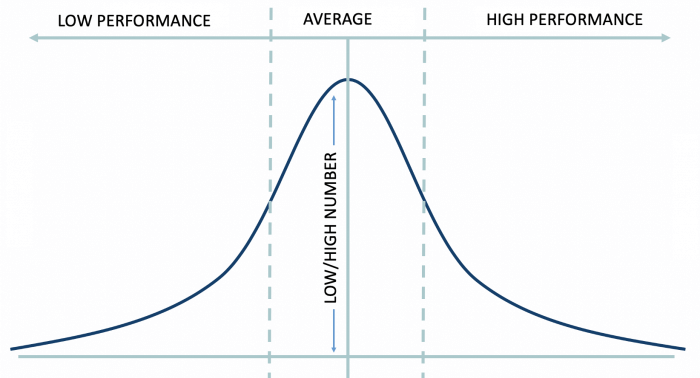
When looking at salary distribution in the ‘West’, you will have a distribution curve something like this:
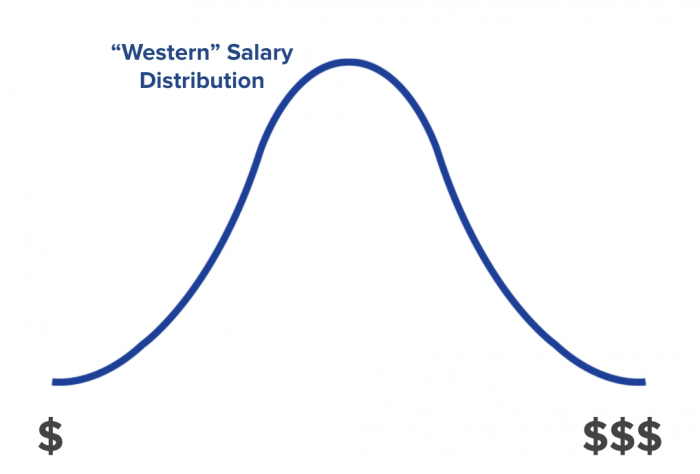
Equally, when looking at salary distribution in the Philippines – in isolation – you will have a distribution curve something like this:
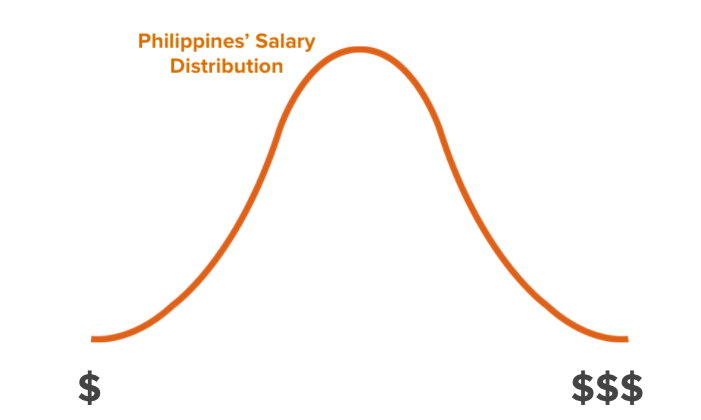
However, if you compare the distribution of salaries in the Philippines and the “West”, it would look something like this:
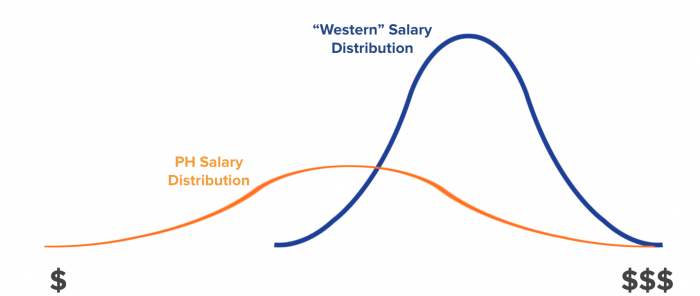
Here’s an explanation of what we see:

The area marked as “C” would represent the salary range that the majority of employees earn in the ‘West’. you can see that some people earn above this and some earn below this, but most people earn an ‘average’ salary.
The area marked as “B” would represent the salary range that the majority of employees earn in the Philippines. You can also see that people in the Philippines can also earn above, and below this ‘average’ level. In fact, the spread is much much wider. In the Philippines, you can have people earning $1 per day and $1m per day. This spread is much wider than what you would commonly see in the West.
The area marked as “D” illustrates that you have some people in the Philippines earning the same high amounts as people in the West – though not quite as many.
The area marked as “A” illustrates that in the Philippines you have people that are earning very very low sums of money – you would not see this in the West.
There is a slight crossover of sections B and C illustrating that the highest earners of the Philippine average salary band might earn a similar amount to the lowest earners of the average salary band in the West.
Optimal pricing strategy
So if you are wondering what you should pay people in the Philippines, to get best results – then you should pay them the standard salary for their region. If you pay too little, then you drop far down the spectrum, and you will get poor candidates and poor results.
In short, you are able to pick from the low end of the market much more in the West, because the bottom fo the market is not that low. It is not that much below the top of the market. The market distribution is generally much more compacted in the West. This is a great thing and is a testament to the high levels of literacy and public school education etc. Unfortunately, many of those social safety nets don’t exist in the Philippines, and so the distribution fo quality is far more diverse.
NOTE: From a social and ethical point of view, this is not a good thing – but it is a reality. Eventually, as the world globalises, I believe that this will even out, and the whole world will become well-educated and have more even access to more equal opportunity (but that’s another subject for another day).
The good news is that a good-to-great salary in the Philippine is still significantly cheaper than a low-to-average salary in the West (50%-90% cheaper!).
Also, it is interesting to note, that people in the West have a fantastic opportunity to hire the best performing (ie highest paid) candidates in the Philippines. They are affordable, whereas the best performing candidates in the West are generally too expensive to consider. And this is where you will see the most value and highest savings.
So before you spend all your time seeing if you can find a $2/hr Virtual Assistant (VA) instead of a $3 VA, you would be better served to see if you can find a top-level developer in the Philippines for $50,000 per year, instead of having to pay $250,000 per year for an equivalent US-based person. Paying $50,000 in the Philippines gets you at the high end of the salary distribution curve – which gets you a great pool of candidates. And it can potentially save you $200,000 per year. That is where the true value of outsourcing lies.
General distribution laws apply
Like the 80:20 rule, the bell curve distribution also applies to most aspects of life (and business). And the differences in distribution between the Philippines and the West also generally apply. It’s worth bearing in mind when comparing like-for-like across the two markets. For example, education standards might look something like this:

Work from home?
When Western employers decide if their Philippine team should work from home or a from a professionalized office, some may opt for them to work from home. It definitely saves the employer money. But many aren’t aware of the typical conditions that home-based freelancers would work from. This is especially the case if you are looking for the cheapest VA you can find, with someone working from the Philippine provinces.
People might casually assume that a cheap home in the Philippines is equivalent to a cheap home in their home country. But this is not the case. Many Philippine homes are very basic, and often cramped. They can commonly suffer from poor lighting, unstable electricity, unreliable internet, and have no proper designated workspace. This can have a dramatic effect on the quality of work produced.
In short, the distribution of quality of housing would look something like this:

This is why we recommend that prospective employers opt to pay a little extra and have their staff work from a professional office environment. It will cost you more, but quality and productivity will be higher, you will attract a better quality candidate – and… you will still save 60%-70% on all-in employment costs.

Outsourcing options
There are different ways you can outsource your work to the Philippines. You can either hire a freelancer or through a ‘BPO’ company. There’s a big difference in terms of price, quality and scalability between the two.
Freelancing
There is a massive world of freelancers in the Philippines. They are one of the biggest ‘suppliers’ on freelance platforms like Upwork, Freelancer, Fiverr, and the portal called OnlineJobs.ph. These freelancers can work for you full-time, but most are either project-based or part-time.
Some of them work out fine. Their price will be somewhere around $300-$600/month.
However, at that rate, there are more disappointing ones than good ones. They might be your full-time dedicated client, but they also start to juggle other work, and then even other clients. Some of them turn into ‘agents’, where they then start to manage other people under them to get the work done.
Another thing is that all of these freelancers are ‘home-based‘. This concept sounds okay in principle, but note that a Filipino home is not like a typical home in the West. They would be working in basic conditions, with usually unstable internet connections, limited electricity, and basic equipment.
These freelancers very rarely pay any taxes and thus have no health cover or general security. This is no way to run a long-term scalable solution.
Business Process Outsourcing
There is a professional version of the above, which is referred to as Business Process Outsourcing (BPO). One of its methods for hiring is called ’seat leasing’ or ‘staff leasing’. These professional firms will manage the recruitment process and will pick from pools of well-educated people with good track records.
When hired, the staff will come into the city and into an A-grade office space. The BPO will provide this, as well as the latest hardware and good internet. Also, rest assured that your team will have proper employment, full HRIS, health insurance, etc.
The company will set disciplinary procedures if the staff fails to perform. They will also provide a professional but friendly environment for the staff so that they enjoy coming into work, enjoy and learn from their colleagues. It is just like a standard professional environment you would expect in your hometown or any country in the West.
Successful outsourcing – the budget
One of the big concerns with either hiring a freelancer direct or someone through a BPO is the budget.
You can potentially find a good person at $300/mo (freelance working from home), so you might feel ripped off if you end up paying $1,500/mo.
But it’s easy to forget that the equivalent person might cost $6,000/mo in the West. That’s a saving of 75%!
So people can become fixated on finding the ‘perfect $300/mo employee’. And this is where it all starts to unravel. It is virtually impossible to find that perfect $300 employee. They might be out there, but they are as rare as unicorns. And even if you do find them, they are undervalued for some reason, and so the great ones won’t stay long.
If you are relying on finding ‘unicorns’ at $300 per month, then you aren’t building something that is sustainable or will scale. You might get lucky with one person. But you will more often than not, be disappointed, and can commonly get frustrated.
That’s why you hear so many stories of people trying outsourcing and saying “it doesn’t work”. Some people take ‘two steps forward, then two steps backward’, and after a while give up.
Offshoring 101: Before hiring a team
It’s entirely up to the management team if the company is hiring directly or through an offshoring company. Hiring directly might be a little bit more expensive and a hassle but you have 100% control over your employee.
On the other hand, offshoring firms serve as third-party agencies where you can get a fleet of offshored agents to work for you. With these agencies, offshoring is a little bit less expensive and less of a task to do.
Offshoring is normally considered as a sub-branch of outsourcing. With offshoring, employees located on the other side of the world, with the opposite time zones and work schedules, will work to help your company progress.
One of the benefits of offshoring (or offshore staffing) is that you don’t have to deal with your prospects’ paperwork. You can also customize your team to your campaigns. Scalability isn’t a problem as most firms have a problem allocating more workers to your account.
The practice of offshoring offers the most flexibility for decades-old organizations and start-up companies.
Hiring an offshore team
The type and quality of offshore staffing candidates can vary greatly – just like in any labor market. Many of the ‘valuable stereotypes’ we take for granted in our own home turf, can be applied to the Philippines also.
If you are looking for strong employees to drive your company forward, those candidates would typically be living in one of the major cities, have attended prominent universities, and have a stellar CV of working for blue-chip companies in one of the main central business districts (CBD). You would expect that these staff would have the routine of getting up every morning, going into the city, and working in an office alongside senior professionals and colleagues.
Having your staff work from A-grade office facilities not only allows an employee to work more efficiently, but it also brings a whole host of side benefits. It creates a professional environment, an environment of routine and discipline, and healthy competition and self-improvement.
This is especially important if you aim to build a team of more than one person. It is more efficient to have all of your Philippine staff working from one office. There is an enormous benefit in having all your staff turn up to the office at the same time, have morning meetings, have those ‘water cooler moments’, and actively share the essence of your company – the mission, values, etc.
Outsourcing cost
If you use a proper outsourcing supplier, then you end up paying a little bit more, in a lot of places, which adds up to considerably more money. But you are opting for professional staff, working in a professional environment, that work to a far higher level. Also, you’re typically getting someone living in central Metro Manila, which naturally commands a premium (just as someone living in Manhattan does).
However, considering all of this, you will still be saving 50%-70% compared to your at-home all-in costs.
That is worth repeating:
Considering all of this, you will still be saving 50%-70% compared to your at-home all-in costs.
Too many people get caught up chasing the pennies, and not concentrating on building a valuable team. People are especially distracted when they see that they can hire people online for $2 per hour. But as explained, these people generally do not provide long-lasting valuable, sustainable results.
Instead of focusing on saving an extra $1-$3 per hour, it is much more advantageous to pay $6-$9 per hour as an all-in price (including HRIS, government contributions, office space, hardware and account management). You will still be saving 50%-80%. Be happy with that. There is a marked diminishing return if you try and chase more.
The people that chase the 80%-90% savings end up shooting themselves in the foot.
Price structure
For a full-time person doing a range of moderate-skilled admin roles, the typical cost breakdown in USD per month can be (all approximates):
- Base salary: $400-$600 (instead of $300)
- Government contribs., HRIS & health insurance: $80-$120 (approx. 20% of the base salary)
- The legal entity to employ and manage the employee: $150
- A-grade facilities, hardware, internet, account management, etc: $250-$650
- Total: $880-$1,520 /mo
Note: This is much more expensive than $300 per month, but it is still much cheaper than the US/UK/Australian equivalent. And also bear in mind that this is a turn-key service and an all-in cost which covers every hidden extra associated with employment.
Note: There’s also an option to get extra guidance from the BPO supplier. BPOs specialize in optimizing processes. They have built out and managed the process you require and are experts in recruiting and managing Filipino teams and getting the best out of them. They can help you with all this, and save you a lot of time, stress and money.
Regardless, you will get significantly better results and can build a strong, sustainable organization.
Can I pay ‘commission-only’ for sales?
Many would-be entrepreneurs ask for commission-only (or very low base salary) sales teams that are incentivized by making sales. The entrepreneur promises that the sales agents will get rich – if they only sell enough product… and the entrepreneur’s product is the ‘best product in the world’… and they are seeking ‘a small sales team’ of just 5-10 people to get this tested. Oh, and btw, the entrepreneur hasn’t actually sold any of the products yet and doesn’t really have an established process.
In short, this does not work. Here are some key reasons why:
Salespeople are staff, not entrepreneurs
If you look at the best and biggest companies in the world – none of them have commission-only sales teams. Think of Salesforce.com, Hubspot, Google, Amazon, Walmart or Disney. Sure, they do get paid commissions, but they also get hefty base salaries plus all the standard healthcare and benefits. Why? Because good salespeople attract good employment packages – just like any other employee in a business. In fact, because sales teams can literally make, or break, a company – salespeople are often compensated better than most other employees in a company. Proper companies realize that sales processes do not just happen. It takes months or years of building, testing, and refining process before you build an effective sales process sales team, and cost-effective sales function.
How much does it cost to “sell”?
If you have a good sales process, supervision, and training in place, then you can possibly get entry-level lower-cost people to follow the process, execute well, and generate good sales. However, you have to consider who has built that sales process? It is a very different skill set to ‘engineer a process’ than it is to ‘execute a process’. I know of some sales experts who charge $50,000 for an 8-hour training day. Their ‘value’ for 8 hours to a company is $50,000!! This implies that sales processes and techniques aren’t inherent – you have to design and build them. If you expect a team of highly paid experts to design your sales process and build a winning sales strategy and team for you – for free – it will not happen.
You will get desperate people accepting the job – they will fail
If you kiss enough frogs, you will find your ‘prince’. So if you ask around enough, and scour Upwork and Freelancer, you will find an inexperienced optimist who will accept your offer of a ‘free’ job. They might be ‘wowed’ by the enthusiastic pitch of your own product, and excited by the potential commissions – so they sign up. But they are not sales experts, and they will not be able to build the system you are hoping for. Sales don’t just happen. It takes expertise, patience, and months of systems building and iteration.
Smallest sales company
Generally, you will find that the people or companies that accept commission-only arrangements are small unsophisticated companies. If this is the case, you should ask ‘why’. As the saying goes, if you can sell ice to Eskimos, then surely the company would be able to sell their services to millions of clients and be able to build the world’s biggest sales organization. If selling was no problem for them, then they would be huge – and probably, since they grow so large, they would start charging upfront for their world-leading services.
How much is $1bn in sales worth?
If I could sell $1bn of your product this year, then I would make your company a $1bn company. How much is that worth to you? And what has no one done it yet? Generally, there is a counter-linear relationship in selling. It is harder to sell the first $100,000 of the product than it is to sell the $1m to take sales to $10m. if you are already selling $10m of product, it is very easy to sell the next $100k.
Why not sell for Nike, Apple?
If I was to build a sales team working for free, then why would I choose your product? If I was working for free, it would be a bad choice for me to tale on the risk of selling a new untested product, with low brand recognition. It would be much easier to sell Nike, Coca-Cola or Apple products. Those brands are already selling trillions of dollars of product, it is a proven product in a proven market, and they have high brand cachet. If I was to work for free, why would I choose an unknown small company that doesn’t have the cash to pay a basic salary?
If free, why not 10,000 people?
If the sales team costs you nothing, then why stop at 5 people? Why not blitz the market. Go all-in. Why not? It is costing you nothing. Why not hire an army of 10,000 people (for free). After all, 10,000 people hitting the phones for free, will outperform 5 people hitting the phones for free.
In reality, the economics of working for free just doesn’t work.
I found a cheap agency – now I’m disappointed. Why?
We get a lot of clients coming back to us. They found the initial price too high, and they eventually found a cheap agency that they went with instead. Fair enough. But then the work is not up to standard, or they get ripped off, or worse. And then they come back. Here are some of the common pitfalls with cheaper options:
Low-quality staff
The biggest cost is the staff salary. Sure, you can find very cheap people on this planet but can do the work you need at the quality you need (as explained in detail above). And can they do it professionally and autonomously, without you holding their hand?
Quality blindness
The standard ‘quality of work’ that is taken for granted in the West, is typically not at the same level in developing countries. Developing countries generally suffer from poor education systems, less mature markets, and lower levels of sophistication. A staggering number of Philippine citizens do not have bank accounts (80%), internet access (65%) of pay taxes (70%), and a large number are illiterate. If you recruit the ‘wrong person’, their interpretation of a ‘good website’ or a ‘ great poster design’ might be very different from your interpretation. There definitely are very well-educated people doing great work, but it is the exception rather than the rule, and the great people get paid the higher rates.
Over-allocation of hours
Commonly agencies will over-allocate staffing hours. You might ‘hire’ someone for 20 hours per week, but your allocated resource is catering to 4 clients at 20 hours each, so you’re really only getting 5-10 hours of attention.
Bait and switch
You’re sold a great resource at a great price, but then someone else does the job – or multiple people do the job. This leads to low-quality output, no accountability, infuriating training processes, and inevitable disappointment.
The best approach to outsourcing
As the saying goes: if the offer is too good to be true, then it probably is.
Trying to find the cheapest people working from the cheapest areas in the cheapest conditions and expecting great things for them in return doesn’t work in any place. Not even the Philippines, your home country, or anywhere in the world.
Their price might depend on the competency that they have or the quality of their service. The freelancer might not have enough expertise and skills required for the tasks. The company, meanwhile, might not have that good feedback you expect from their customers. In return, the quality of their work is sacrificed.
The best approach when doing offshore staffing is actually the opposite. Your company has a relatively enormous ‘buying power’ in the Philippines. So you can afford to seek out the best possible employee for your needs.
You can go to the Philippine equivalent of Harvard university, hire the most successful Ph.D. student, who would otherwise be hired by one of the top local firms. This is an option for you in the Philippines, whereas you could not afford this in your home country – only Google would afford this in your country.

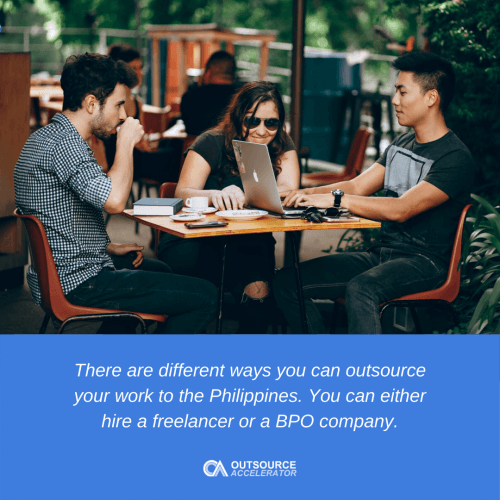

 Independent
Independent





















